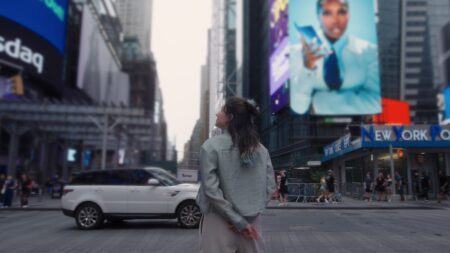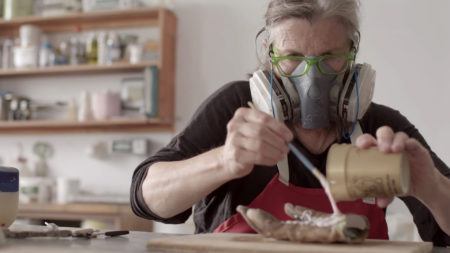Interview
Public Art
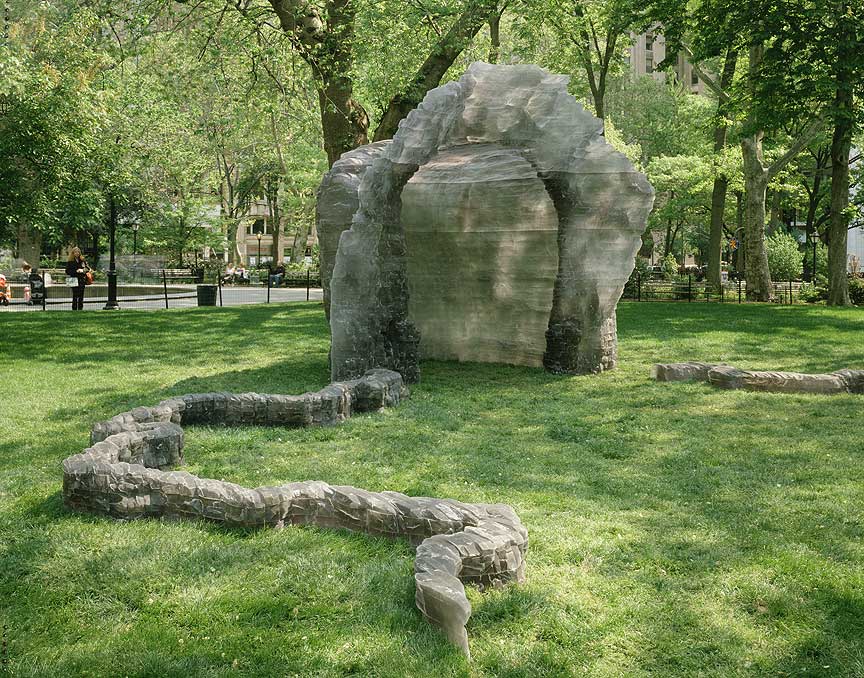
Ursula von Rydingsvard. Damski Czepek, 2006. Polyurethane resin; 143 x 406 x 400 inches. Installation at Madison Square Park, New York. © Ursula von Rydingsvard. Courtesy of the artist and Galerie Lelong, New York.
Ursula von Rydingsvard discusses her motivations for creating work in public spaces, and her 2006 series of public sculptures installed in New York City’s Madison Square Park.
ART21: Tell us about your four pieces, including Damski Czepek, that were installed in Madison Square Park in New York City.
VON RYDINGSVARD: I think the project at Madison Square Park evolved about three years ago. The urethane bonnet was extraordinarily time-consuming. I did the entire bonnet out of cedar first, and the cedar walls were very, very slender.
I sent that bonnet—a life-size form in cedar of exactly what was made in urethane—across the country, to the Walla Walla Foundry in Washington. I think it’s the biggest pour that was ever done, in the history of this kind of urethane. And there were huge amounts of things that failed, in the process of learning how this material works. I wanted a transparent look of walls that the light went through. I wanted a very agitated surface. And the hood that is over the bonnet—almost like a little porch—is very erratic and very celebratory, and it needed that translucency of the light. It’s not just the sun. When the skies are cloudy, there’s a whole different thing that happens with that material.
It’s one of only two pieces I’ve made that actually get used by the public. The other one was the Microsoft piece. It’s the only outdoor piece that the Microsoft campus has. This one has two little rivers on the side that are also made out of the urethane—a kind of beckoning to go into the center of this bonnet.
ART21: Have you observed people interacting with Damski Czepek?
VON RYDINGSVARD: I have, and it’s not what one would think. I tend to be so protective of that piece getting harmed or hurt, that I would rather not be around it. But I think—more critically—I don’t want to hear what people say about the work. That often feels all wrong to me. Not that I want in any way to direct what they think or their reactions—I just don’t want to hear it.
I think there were twelve marriages that took place inside the bonnet. It’s been so used, in fact, that we’ve had to change the grass. This is the third time that we’re putting in the new—uh, what do you call that grass that you unroll?
ART21: Sod?
VON RYDINGSVARD: Yes, sod. We replaced the entire interior of the bonnet many times already because it’s been trampled on and used. Actually, I shouldn’t be so negative about my observations. There were times when I loved seeing it used, when it made me feel like the piece was a big success. I knew that people were going to interact with it, but it’s one thing to know it, and it’s another thing to watch it. What happens when the layer of sod is worn out is that there’s a pathetic look to it. It looks like a wet puddle with earth underneath. That makes me feel as though the piece deserves a better context. So, we replaced the sod, and she looks proud again. Then I’m more able to embrace people’s use of that piece.

Ursula von Rydingsvard. Czara z Babelkami, 2006. Cedar; 202 × 125 × 74 inches. Installation at Madison Square Park, New York.. © Ursula von Rydingsvard. Courtesy of the artist and Galerie Lelong, New York.
ART21: Is making public art, or art in public spaces, important to you as an artist?
VON RYDINGSVARD: I come from people that have never been to a museum before in their lives. I don’t think they even know what a museum is. People, meaning my parents: they could barely read and write.
To be able to show my work to a public at large is important. People are not entering any holy place that’s meant only for art. Art is not placed on a platform. And I strongly believe it doesn’t have to be, in order for it to still be potent. There is a way in which people can engage or not engage—on their way to work, on their way to get a shake. It doesn’t have to be a serious, genuflecting, silent, deep-rest kind of thing. It can be much more casual and easy. So, it’s a real privilege to have had this opportunity.
ART21: Have elements from your upbringing crept into the pieces here, in the park?
VON RYDINGSVARD: I had a sweater as a little girl in the refugee camps in Germany, and it was hand-knit out of unbleached wool from sheep. It had wonderful babelkami (popcorn stitches) on it, on the grid that was at the top part of the body. And of course, in no time at all (because it was not as though I had more than one of these—it was actually the only sweater I had during all those years) it got worn on the sleeve, around the shoulders and around the belly, so that it was kind of wayward. The grid got disrupted. It went organically wayward. It started flowing; it started falling. So, I used that, or a kind of intrigue with that, in part, as a source of my imagery for this enormous bowl—actually, the biggest I’ve ever built. She sits there, and her profile from the side is very slender. From a three-quarter view, she spreads out. She’s like a sail, eleven feet wide at the top.
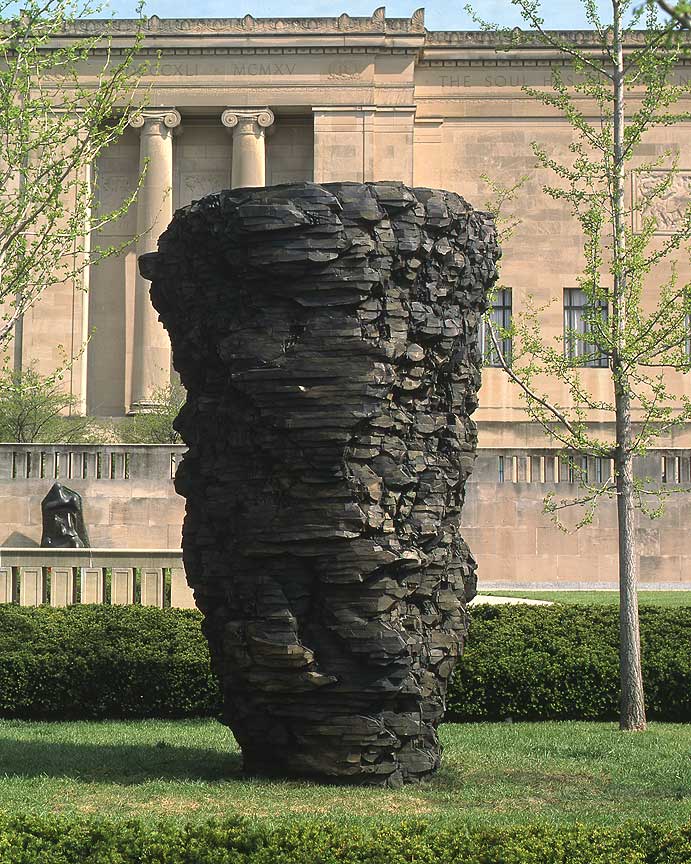
Ursula von Rydingsvard. Large Bowl, 1997. Cast bronze; 13 1/2 × 9 feet in diameter. Installation at the Nelson-Atkins Museum of Art, Kansas City, Missouri. © Ursula von Rydingsvard. Courtesy of the artist and Galerie Lelong, New York.
ART21: Have you taken your parents to see your work?
VON RYDINGSVARD: Actually, my mother’s been to an exhibition. I took her to the exhibition at Storm King Art Center in New York. I think her understanding of my work was something that I couldn’t have predicted. When she looks at my sculptures, she refers to me (in Polish) as a chicken that keeps digging into the mud to get little seeds. That was her reaction to the work. And then to Storm King itself, to all that beautiful landscape and space—she asked me, “How much did you pay to rent this place?” That’s the realm of her understanding of those situations. Of course, there is no such thing as renting Storm King. They ask you to do the exhibition, and then you react to the land as you see fit, with your work.
ART21: How did her comment resonate with you?
VON RYDINGSVARD: I think the image is a good one. I mean, it’s insulting, but it’s good. There’s a futility in it, too, and a reference to constant work.
ART21: Where did the bonnet form that you’ve used in your work originate?
VON RYDINGSVARD: The idea of a bonnet surfaced in connection with a piece I made for an enormous private farm in the southwestern part of Massachusetts, about two years ago. I chose a spot in the woods that wasn’t dense with trees. It was a little circle, and in it I placed these bonnets facing outward. Below, there was a ravine where water trickled down. So, it was almost like a stage. I looked at the entire one hundred fifty acres and fell in love with this part. It was my reaction to the land that motivated me to make those structures around it.
ART21: How did the title for the bonnet piece come about?
VON RYDINGSVARD: I never wanted to be literal. I never want the explanation to be so simple and so clear with a hard dot at the end of it. But I didn’t know how else to refer it. In the process of working, I always need a working title. And that was the working title, The Bonnet. I tried so hard to get rid of it. I tried not to make references to it, with the people that I worked with at Madison Square Park. But it just kept falling out. But the name that I have finally titled it is Damski Czepek. Czepek is something that belongs to the Old World: a bonnet for a woman. Damski means “belonging to a woman.”
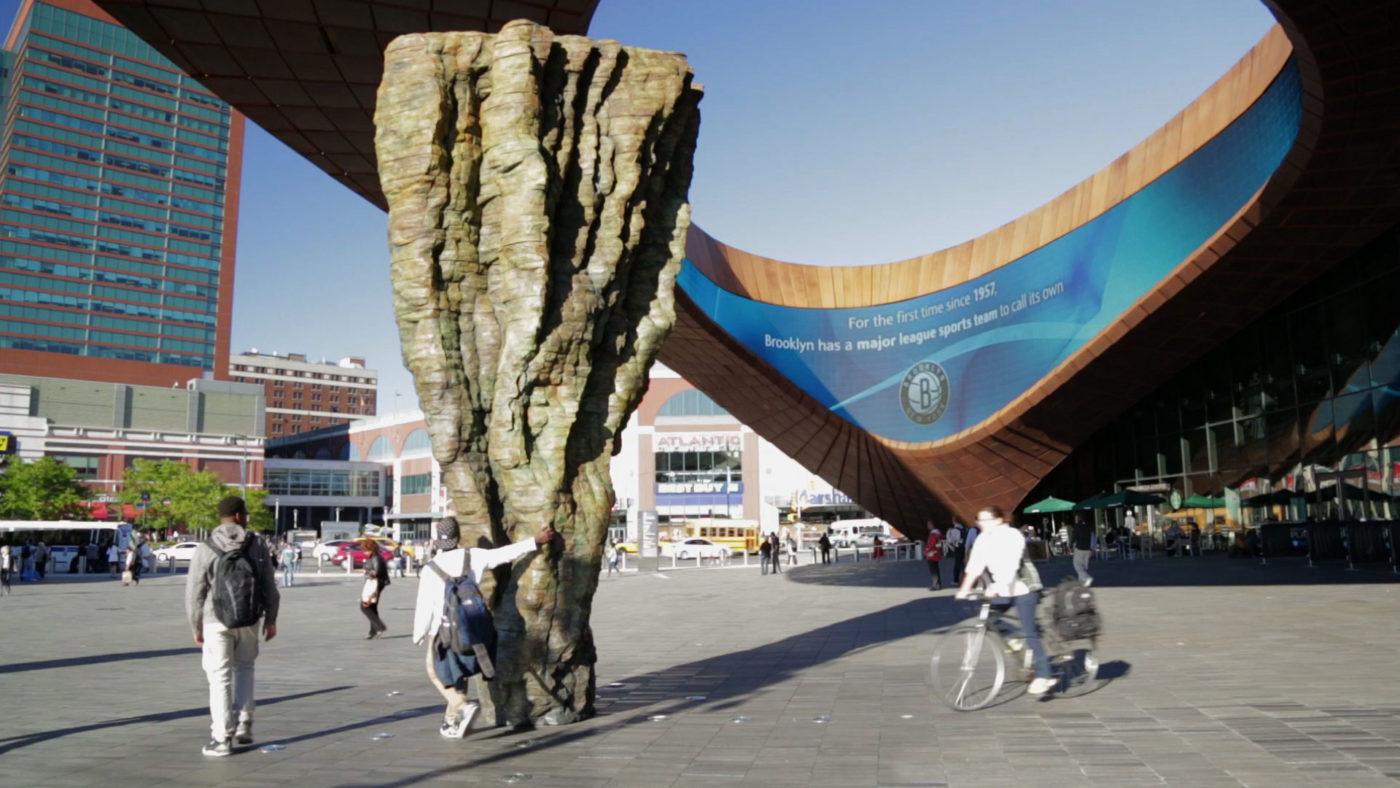
Ursula von Rydingsvard’s Ona (2013) installed outside of the Barclays Center, Brooklyn, New York, 2013. Production still from the Art21 Exclusive episode, Ursula von Rydingsvard: “Ona”. © Art21, Inc. 2013
ART21: Are you influenced by other sculptors or sculptures?
VON RYDINGSVARD: I’m not even sure that it’s sculpture that I drink the most from to reap imagery for my work. I think it’s vernacular architecture—everyday kinds of objects like bowls and cups—that enables me to springboard. And that gives me a lot of room and a lot of leeway, because none of it has been so explicitly defined. Usually the utilitarian object is just that; it’s made to be used. And the whole design, if one wants to call it “design,” is made for the purpose of its being used, so that the options surrounding it are huge.
If I were to say how it is that I break the convention of sculpture—and I’m not sure that’s what I do or even if that’s what I want to do—it would be by climbing into the work in a way that’s highly personal, that I can claim as being mine. I have this feeling that the more mine it is, the more I’m able to break the convention. So, it’s not radically erasing, with this drama, what’s been done in the more immediate past. It’s more like finding many ways into the work that feel potent psychologically—that feel potent emotionally—but only feel potent for me. And maybe that’ll overlap onto what others might or might not see. But I think the most important thing for me is to figure out what it is that’ll give me a rise, what it is that’ll turn me on, what it is that feels really interesting to me. Or, what it is that feels compelling—why I would be driven to do something like that seventeen-foot bowl with all the babelkami on it.
I strongly believe in the individual, as opposed to the institution. Whether it be a religion or a corporation—whatever the nature of the institution—I strongly believe in the potential of the creative process.
ART21: What kind of projects do you hope to complete in the future?
VON RYDINGSVARD: There’s this strong desire I have to make a sculpture. I think that this will have to be on a scale that I’ve never worked on before, and it won’t have anything to do with a series of objects. It’ll be the point at which something manmade meets nature.
I’ve seen many of the ruins in Mexico, Guatemala, and China. I’ve seen them all over the world. I love looking at those moments—when nature has encroached upon something in a very dramatic way, yet you can feel the lines of man absolutely involved in that composition. And usually these things are quite low to the ground because the walls are already eaten off.
I’ve had dreams of making a stone cliff. I’ve had dreams of taking the implications of what nature has already done, and then starting to build on top of that with the same kind of stone, but much more obviously manmade. I keep thinking that the trickiest part would be the point at which the stone that I cut would meet nature’s stone. It’s something I would love to do.
